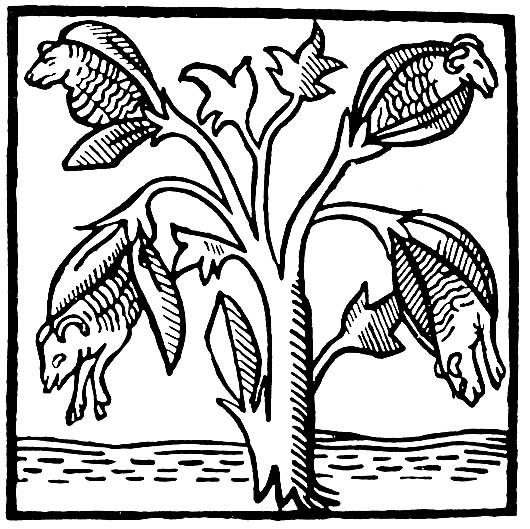Weaving global history and ethnobiology
Weaving global history and ethnobiology
Much of our daily work as ethnobiologists asks how social and environmental relationships are built, sustained, and broken. I’m much better trained in social science than in botany, but as an ethnobiologist researching the connections between the clothing we wear and sustainable farming in the field, I also pay close attention to the ecological needs of the plants and animals living alongside farmers. The cotton grown in India is susceptible to a wide range of insect pests, and Indian farmers go into debt to spray pesticides and grow crops genetically modified (GM) to ward off bollworms. In the worst cases, when debts rise, crops fail, insects attack, and desperation mounts, some Indian farmers drink pesticide to end their lives. Although some elements of this crisis are ecological, they aren’t necessarily natural: commercial cotton needs a lot of fertilizer to fruit and flower, the plants need pesticide protection from hungry insects, the insecticidal genetic modification expresses a gene that makes a protein toxic to caterpillars of the Lepidopteran family but does not affect other insects. Ethnobiologists ask deeper questions that put that natural lie to rest – why grow cotton in India? Why grow it in a monoculture? Why is the margin for error in cotton agriculture so thin that people die for it? These questions drive my work in Telangana, India.
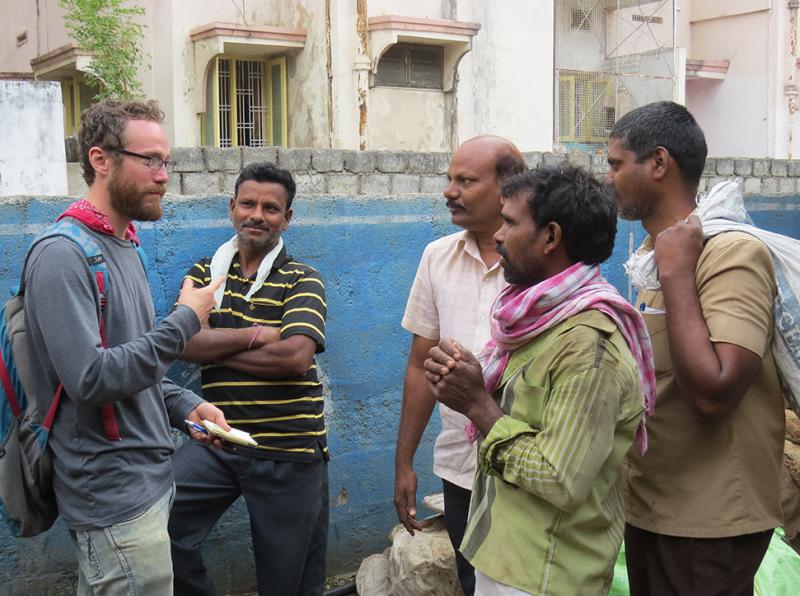
The author speaks with cotton farmers in Telangana, India, Photo credit Ranjith Kumar.
The global history of cotton is the history of capitalism, empire, and slavery, told across thousands of years of transnational connection. Cotton buoyed the Indian Ocean trade that drove Europeans to sail West. The notion of a plant capable of providing faster, cheaper, lighter, and higher-quality textiles so captivated the imaginations of Europeans used to wool and linen that naturalists and clothes-wearers alike, aided by the writing of Sir John Mandeville, imagined cotton as a tree that bore tiny lambs that bleated from its branches. That particular misconception survives in the German baumwolle (tree wool), but most Europeans take their words from the Arabic qutun, in honor of the traders who brought it to their shores.
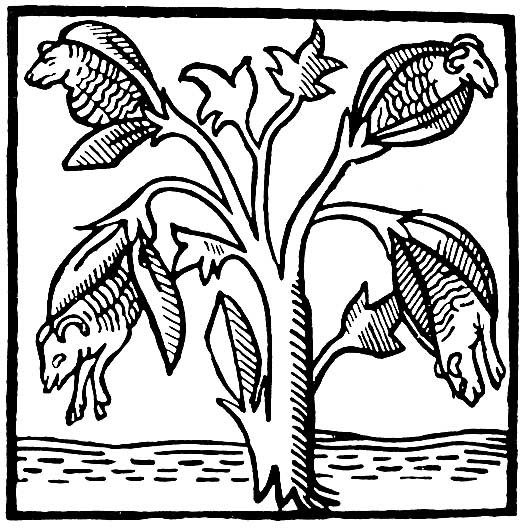
Cotton, as imagined by Sir John Mandeville in The Travels of Sir John Mandeville
Cotton fueled the rise of mills in Manchester and Boston, clothing displaced and enslaved African people who grew cotton in American plantations so that their European and American enslavers would grow wealthy. Europeans saw in cotton the opportunity to build a new kind of empire based on the extraction of commodities, land, and labor from colonial regions, and the investment in urban manufacturing back in the core of the nation. WQhen the American colonies separated from the British Empire, they took with them a New World cotton industry built on enslaved labor and cottons well suited to mass production. New World cottons, Gossypium hirsutum L., and Gossypium barbadense L. had a longer staple, or fiber, length that was better suited to mechanized weaving in England, while South Asian cotton, Gossypium aboreum L., had a shorter staple that fit Indian handlooms. (For a review of cotton’s global history check out Sven Beckert’s excellent book, Empire of Cotton, and ethnobiologist Gene Anderson’s excellent review).
Irritated by competition from these industrially superior New World varieties, the East India Company invested in infrastructure and experimental farms, even hiring American planters to teach Indian farmers to grow new varieties for mass production in 1840. The going was slow. British-Indian cotton strains yielded 25% more, but only with a 200% higher cost in production capital. Few Indian farmers found this trade-off appealing – it’s not as though they themselves reaped higher wages, and the new system of production asked them to invest heavily in cotton at the expense of planting food crops or crops destined for side markets. Why devote such risk and resources to enrich foreigners? Indian cotton would not gather global market shares until a global cotton drought brought on by American civil war. Thinking it might force British help, the American Confederacy first banned exports – by the time they realized that they were bankrupting themselves, the Northern blockade was so effective that Southern exports to Europe, totaling 3.8 million cotton bales in 1860, dropped to virtually zero in 1862. That same year, Indian cotton farmers provided 75% of the British cotton and 70% of the French cotton spun into clothing. By the late 19th century, Indian farmers had developed a successful cultivar of G. hirsutum L., a variant of the cotton that now accounts for 90% of our clothing.
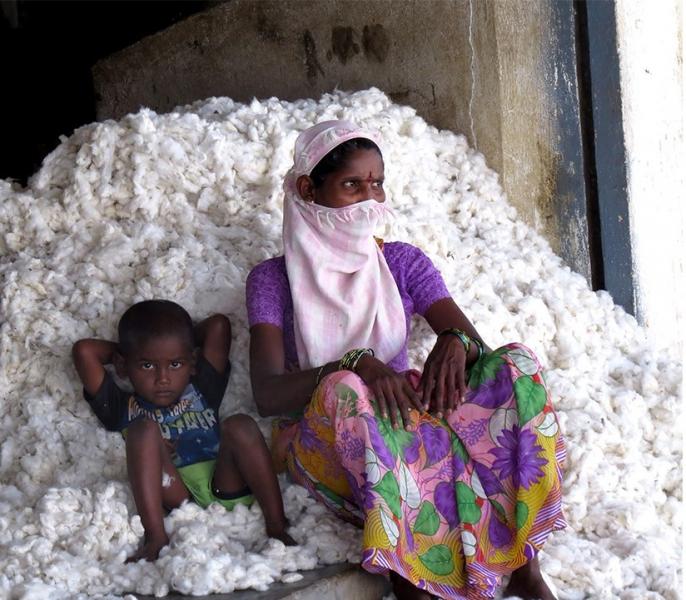
Workers rest during a shift packing cotton lint into bales. Photo Credit Andrew Flachs.
Indian dominance in the cotton sector helped make Gandhi’s Quit India and handloom campaigns central to the Indian independence movement, ending sales to British buyers and focusing instead on building self-sufficient villages. But by the late 1960s and 1970s India shifted decisively toward capital-intensive agriculture. Growth in manufacturing brought synthesized nitrogen fertilizers and chemical pesticides, which in turn encouraged Indian crop breeders to focus on high-yielding varieties and hybrids that would respond to these inputs. Hybrids of G. hirsutum L. and G. barbadense L. provided both a longer staple fiber and greater quantities of cotton bolls, and the state’s industrial and infrastructure priorities ensured that farmers would receive the water to irrigate them, the fertilizers to grow them, and the pesticides to defend them against insects and diseases. By 1998, Indian cotton farmers were applying between 30,000-35,000 metric tons of pesticide, representing as much as 45% of the total pesticide applications in India. This volume is astounding, considering that cotton was cultivated on only 5% of India’s agricultural land.
It would be easy to blame the cotton plants for this rise in pesticides and agricultural costs. G. hirsutum L. lacks coevolutionary resistance to Asian pests, it’s broad leaves provide shelter for bollworm eggs and sap-sucking aphids, and its root is shallower and more sprawling than G. arboreum L.’s deep tap root. To grow this crop to its full potential, farmers would have to defend it with pesticide sprays and dole out more regular and gentle water than the monsoon rains usually provided. An ethnobiologist like myself would argue that this ecological disaster is not completely the cotton’s fault. Like all plants, cotton has been fighting an evolutionary arms race against predatory insects for millions of years.

A cotton farmer sprays pesticdies from a gasoline-powered mister. Photo credit Andrew Flachs.
Cotton’s Gossypium genus derives its name from gossypol, a toxic compound that discourages insects and herbivores from eating cotton in the wild. Found in the seeds, shoots, stems, leaves, and flowers, gossypol has evolved to protect cotton at all stages of its development. Indeed, to use cotton oil for human or animal foods, we must painstakingly remove this toxin. All evolution is a treadmill, or what evolutionary biologists call a Red queen scenario – like Alice in Wonderland, we all must run faster and faster to stay in place as the world changes around world us. Cotton evolves gossypol, insects involve gossypol tolerance, and both must continue forward on this treadmill to stay alive in an uneasy balance of predator and prey. When G. hirsutum L. arrived in India in the 19th century and was grown on a large scale in the 20th century, it was unwittingly thrust into a millennia-old arms race. Indigenous cottons might have had shorter fibers, but they boasted narrower, spiky leaves that discouraged insect hideaways, produced more gossypol, and had evolved to attract bees and ants that liked to eat caterpillars and aphids. With increasing sprays came increasing insect resistance, a pesticide treadmill, in which farmers had to spray ever more to keep up with insect resistance.
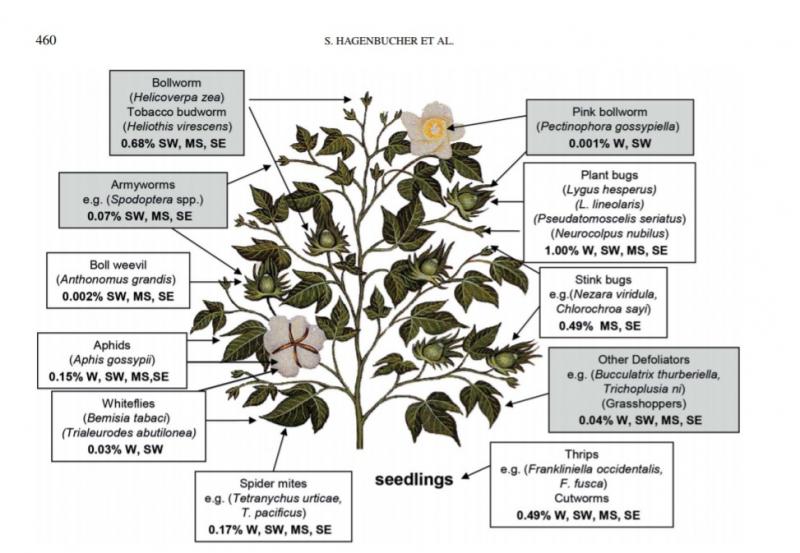
A summary of cotton’s US American pests and vulnerabilities from Haugenbucher et al. (2013).
In the 21st century, GM technology has dramatically discouraged bollworms from eating cotton. Yet like many pesticides before it, insects are beginning to evolve resistance to GM cotton’s insecticidal proteins while their temporary absence has opened a niche for new insects. Pesticide sprays in Indian cotton are now above India’s pre-GMO levels. On Indian farms, G. hirustum L. was especially vulnerable because farmers grew it in monocultures, an artificial and delicious landscape for the numerous pests and crop diseases that feast on cotton. The rise in fertilizers and pesticides brought new debts and insecurities, including a wave of farmer suicides that peaked in the late 1990s. As rural Telangana and India broadly embraced policies to privatize agriculture, farmers previously engaged in reciprocal finance relations with local landlords and ecological relationships with homemade inputs learned to navigate an unfamiliar landscape of credit, labor, seeds and inputs as citizen-consumers. The problem was never the plant – India’s cotton crisis is made by the way that farmers grow cotton, national policies and breeding programs facilitate that agriculture, and global supply chains demand the final white fluffy product.
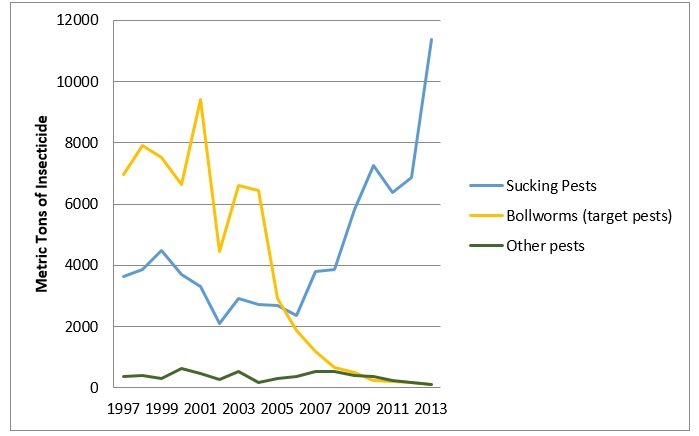
Data Adapted from Kranthi 2014.
Cotton is so ubiquitous in our lives that it is difficult to imagine living without cheap, fast access to clothes, sheets, bags, diapers, or, for US Americans, our cotton dollar bills. In 2018 the world is on track to produce about 120 million bales of cotton, enough to make about 140 billion T-shirts. I can buy a pack of three white cotton T-shirts for $10.00 at my local retailer in Lafayette, Indiana. This is a good deal, considering that cotton evolved and was domesticated in the neotropics, is grown by farmers in places like India, China, Turkey and the United States, is spun, dyed, stiched, and sewn into clothing and other textile products by factory workers in Southeast Asia, central Asia, and sub-Saharan Africa, and comes to me in time for the four, six, eight, even twelve fashion seasons I need to stay trendy. Unpaid in my $10.00 are the costs of water contaminated by cotton dyes, clothing factory collapses, pest attacks, soil salinization from irrigation projects, chronic pesticide exposure, suicide, biotechnology infrastructure, or multinational trade agreements.
Andrew Flachs is an assistant professor of anthropology at Purdue University and a co-editor of Ethnobiology Letters and the Ethnobiology Forage! Blog. He has conducted research in agriculture and ecological knowledge in the American Midwest, South India, and Bosnia. His peer-reviewed research and public writing on cotton agriculture in India can be found at www.andrewflachs.com.
Sources cited:
Beckert, Sven. 2014. Empire of Cotton: A Global History. New York: Knopf.
Hagenbucher, S., D. M. Olson, J. R. Ruberson, F. L. Wäckers, and J. Romeis. 2013. “Resistance Mechanisms Against Arthropod Herbivores in Cotton and Their Interactions with Natural Enemies.” Critical Reviews in Plant Sciences 32 (6): 458–82. https://doi.org/10.1080/07352689.2013.809293.
Kranthi, KR. 2014. “Cotton Production Systems - Need for a Change in India.” Cotton Statistics & News, December 16, 2014.

